
Re-evaluating my Closet

During the beginning of my artist residency, I was intently focused on creating a “Textile Traditions” curriculum for Cook County 4th and 5th graders. Although I have been playing with wool for more than a decade, I really didn’t have a sense of the history of wool and textiles so I did an intensive amount of research. I was fascinated, and it led me to consider just how little we know about what we wear, where it comes from, who is laboring for so little money, what it is made from, and what does it mean to us?
In my research, I began to realize just how quickly our society has moved away from handmade items that are treasured and passed along, to mega malls with endless aisles of cheap choices made by a stranger in a far, far away land. How quickly we have found ourselves busting out of our small homes because we have too much stuff. Our great grandparents could never have imagined we would need closets and closet organizers to hold all of our possessions. It was nearly a century ago that many people made their own clothing or at least knew where it came from and owned basically what was “NEEDED”. The clothing owned was minimal, but it told a story about where they lived, what their ethnicity was, what their livelihood was, and so much more. In the mid 1800’s the most common home industry was weaving cloth, albeit for blankets, clothing, rugs, etc. When this much work went into an item, it certainly was bound to be beautiful, precious and treasured, well taken care of, repaired, and passed on.
Whether the first textiles were made of twisted plant fiber or felted wool, felting wool is likely the most primitive and ancient method of making fabric. Nothing but wool is needed, a bit of moisture and agitation and felt fabric is formed. No spinning of fibers, no looms, no knitting needles--just wool. It’s as simple as putting a pile of wool under a foot for cushion and finding that with a bit of sweat and heated agitation while walking, a matted and durable piece of fabric is formed. Considering the discovery of textiles, there is a curious creation story of felted wool: during the journey of Noah’s ark, a zoo of animals coexisted long enough for fibers to be shed, pee and poo spread and animals wandered about, stomping on everything that ended up on the floor. This created a felted rug to the amazement of all. So simple, but probably not very pretty. Once wool felt was discovered, the possibilities were endless, and still are. From rugs and homes in Mongolia where there were huge flocks of sheep and great expanses of land for grazing; to hats, slippers and mittens in Scandinavia, where fertile land was precious and sheep were few. Looking around, you won’t see many examples of felting in our modern world. Exactly why I have chosen to dedicate my energy to the art of felting remains a mystery to me. Perhaps, because I never learned how to sew and would rather avoid the counting of knitting. Perhaps, wool choose me. I love its simplicity, earthiness, organic behavior with a mind of its own, the possibilities of sculpting with it, painting with it, making things of beauty and making things of durable, warm practicality. I look towards ancient times for inspiration and into a painterly box, full of colorful wool as well. What it can become could certainly cloth me with warmth and beauty. So, why is my closet full of synthetics and fleece made of petroleum rather than wool?!
Considering the fabrics in my closet and I am justifiably concerned about what they are made of. The supposed ecological recycled fleece and many other synthetic fibers have been found as microscopic particles in our environment, floating in water and through our air, being digested and inhaled by all life. I consider what fabric and clothing is a better choice for our environment, for the people who are laboring in factories, for our own personal well being. Wool, seems like a dreamy alternative!
Thankfully there is a societal enthusiasm to support local food, local energy, (and the ever so popular local brews and spirits), but there is a greater challenge when it comes to buying local clothing. First, there are very few of us who are able to make our own clothing. We lack the skills, the time and frankly, there is an easy abundance of second hand stores that could fill our closets with inexpensive options. Secondly, even if you were searching for clothing produced with local fibers and made within the region, you would likely fail to find much of anything available beyond knit sweaters. There are many reasons why this is true (fodder for a future blog). For now I will put these realities aside and with a hearty dose of romanticism and idealism, I am beginning the process of bringing the clothes in my closet closer to home. Given the gift of time, space and security of the Artist Development Program, I am challenging myself to begin replacing things in my wardrobe and life with things that I am able to make with wool. Hats, skirts, backpacks, jackets, slippers, earrings...the list is long. In future blogs, I will add photos of what has been accomplished. Successes and the not so successful.
I'll begin with these photos of the last week and my efforts to make something wearable. The first was a dress that was supposed to be a vest. It was made with Judy Mcdowell, one of my felting mentors who spent a few wonderful days with me in my Grand Marais studio. My dress was a success in the end, but it wasn’t we expected! The last photo is a bit of a failure. I was hoping for a hoodie vest but it’s not something I would wear. There is the possibility of it being salvaged with a bit of effort, shaping, shrinking or stretching. In the worst case scenario, cutting, stitching and repurposing. There is endless learning to be done in the world of wool. Holding onto the memories of success and continuing forward, I will keep on stretching myself, learning from my mistakes and sharing the process with anyone interested.
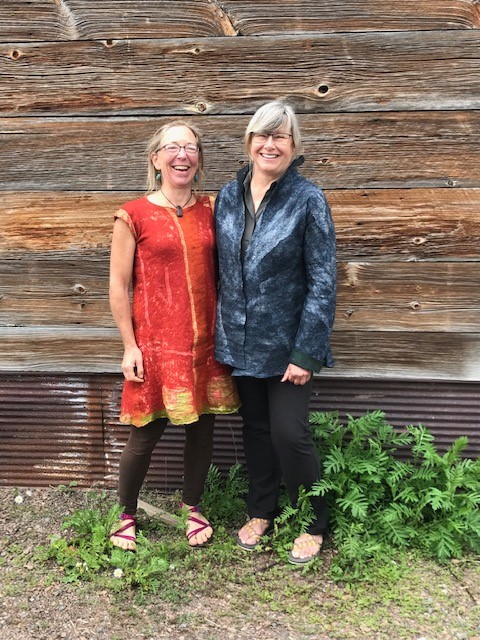
Judy McDowell, one of my felting mentors, and I happily wearing our nuno-felted pieces.
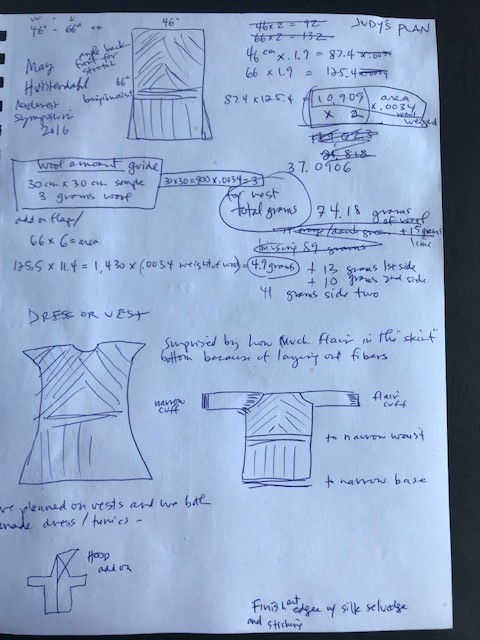
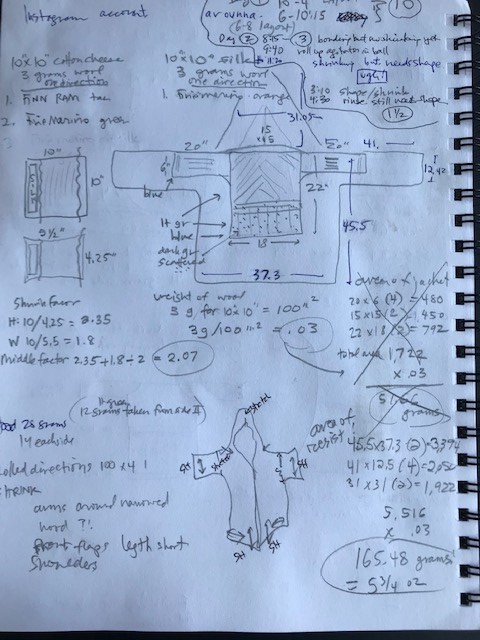
Calculations for shrinking of wool and weight of wool.
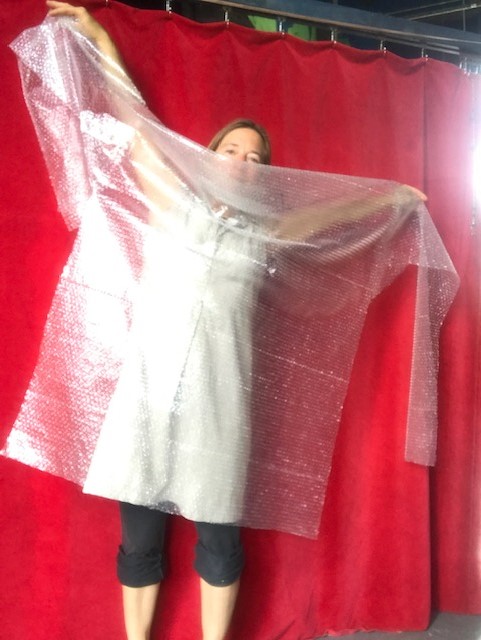
The resist created to make the hoodie vest, considering a 50% shrinkage of the wool.

Cheesecloth and wool laid out, ready to be wet-felted and agitated for a long, long time.
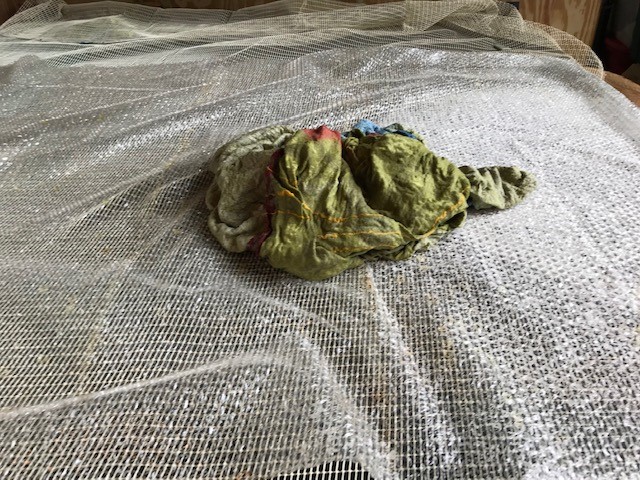
The hoodie being shrunk with hot water and agitation after the fibers have been loosely bonded by gentle agitation and rolling.
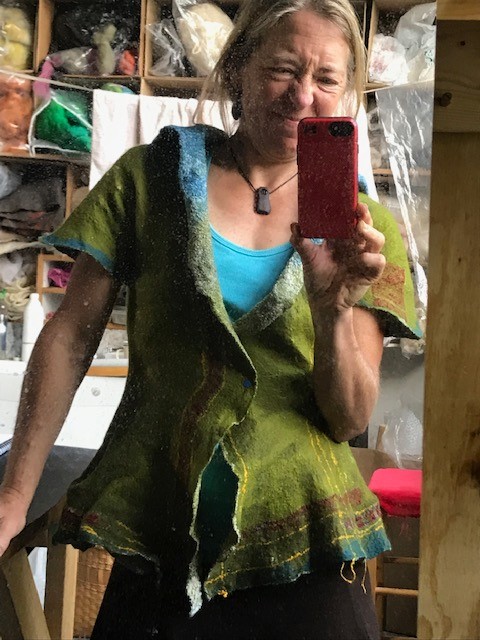
The outcome of the vest is not ideal. To be continued. Not all projects are successes!